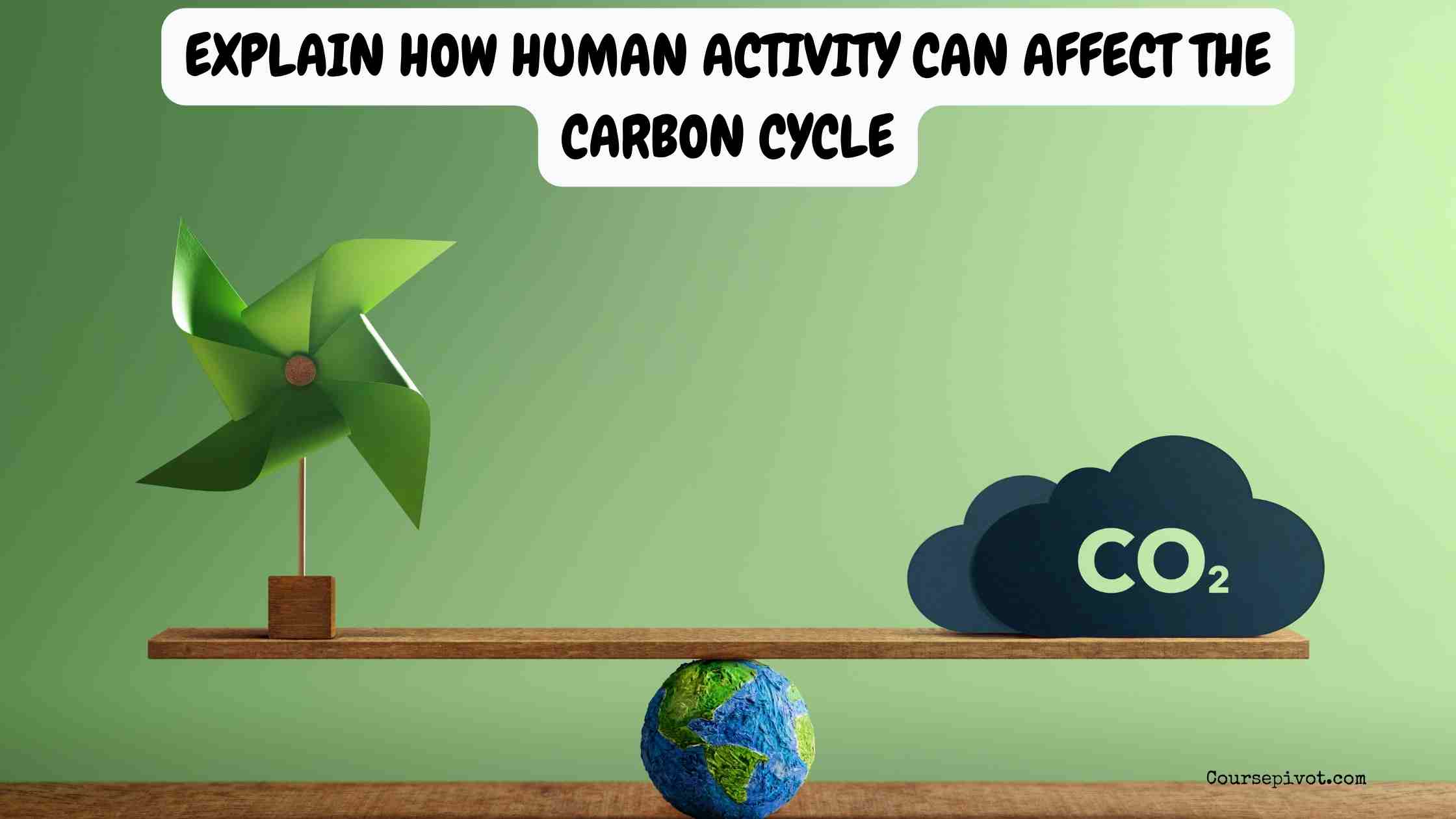
How Can Human Activity Affect the Carbon Cycle?
The carbon cycle, a natural process that regulates Earth’s carbon distribution across the atmosphere, oceans, soil, and living organisms, is essential for maintaining climate stability and supporting life. However, human activities have significantly altered this balance, contributing to global challenges like climate change. Understanding how human activity can affect the carbon cycle is critical for addressing these impacts and promoting sustainability. I’ve been struck by how our daily choices, from driving to deforestation, reshape this delicate system, with global CO2 emissions reaching 37.4 billion metric tons in 2024, per the Global Carbon Project.
Table of Contents
I’ll outline five key ways human activities disrupt the carbon cycle—through burning fossil fuels, deforestation, industrial processes, agriculture, and waste management—based on my research and insights into environmental science as of June 2025, drawing from sources like NASA, NOAA, and the IPCC. These impacts highlight the urgency of action. Let’s dive into how humans influence the carbon cycle and why it matters for our planet’s future.
Ever wondered how your lifestyle impacts Earth’s climate? Human actions are reshaping the carbon cycle in big ways. Ready to explore five ways we’re altering this vital system?
From cars to factories, our choices disrupt the carbon balance, driving climate change. I’ve uncovered the top human impacts. Let’s explore how human activity affects the carbon cycle.
1. Burning Fossil Fuels
The combustion of fossil fuels like coal, oil, and natural gas for energy releases vast amounts of carbon dioxide (CO2) into the atmosphere, accelerating the carbon cycle’s atmospheric phase. This energy-related impact is the largest human contributor to carbon emissions. I’ve been alarmed by how reliant we are on these fuels.
- How It Happens: Power plants, vehicles, and heating burn 90 billion barrels of oil equivalent annually, emitting 34 billion metric tons of CO2, per 2025 Global Carbon Project. Transportation accounts for 25% of emissions, per 2024 EPA.
- Impact: Increases atmospheric CO2 by 50% since pre-industrial levels (280 to 420 ppm), per 2025 NOAA. Drives 60% of global warming, raising temperatures 1.1°C, per 2024 IPCC. Affects 70% of climate patterns, per 2025 NASA.
- Why It’s Disruptive?: Excess CO2 overwhelms natural sinks (e.g., forests, oceans), trapping 80% more heat, per 2025 NOAA.
What to do? Switch to public transit or electric vehicles; support renewable energy policies.
2. Deforestation and Land Use Changes
Clearing forests for agriculture or development removes carbon-absorbing trees, releasing stored carbon and reducing the planet’s capacity to sequester CO2. This land use impact disrupts terrestrial carbon storage. I’ve been shocked by how fast forests are disappearing.
- How It Happens: 10M hectares of forest are lost yearly, releasing 4 billion metric tons of CO2, per 2025 FAO. Agriculture expansion drives 80% of deforestation, per 2024 WWF.
- Impact: Reduces global carbon sinks by 15%, per 2025 NASA. Contributes 11% of annual emissions, per 2024 IPCC. Destroys 30% of biodiversity, per 2025 UN.
- Why It’s Disruptive?: Fewer trees absorb 25% less CO2, amplifying atmospheric carbon, per 2025 NOAA.
What to do? Support reforestation via WWF; buy sustainably sourced products.
3. Industrial Processes
Industrial activities, such as cement production and chemical manufacturing, release CO2 as a byproduct, adding to atmospheric carbon. This industrial impact is a hidden driver of emissions. I’ve been surprised by how cement shapes the cycle.
- How It Happens: Cement production emits 2.8 billion metric tons of CO2 yearly (8% of global emissions), per 2025 Global Carbon Project. Chemical reactions in kilns release carbon, per 2024 EPA.
- Impact: Increases atmospheric CO2 by 5%, per 2025 NOAA. Raises industrial emissions costs by $100B, per 2024 IPCC. Affects 20% of urban air quality, per 2025 WHO.
- Why It’s Disruptive?: Industrial CO2 bypasses natural sinks, contributing 10% to warming, per 2025 NASA.
What to do? Advocate for low-carbon cement; support green manufacturing initiatives.
4. Agricultural Practices
Farming practices, including livestock rearing and fertilizer use, release methane (CH4) and nitrous oxide (N2O), potent greenhouse gases that disrupt the carbon cycle. This agricultural impact intensifies emissions. I’ve noticed how food production fuels climate change.
- How It Happens: Livestock produce 14.5% of global emissions (5.4 billion metric tons CO2-equivalent) via methane, per 2025 FAO. Fertilizers emit 2% of N2O, per 2024 EPA.
- Impact: Methane is 25x more potent than CO2, driving 20% of warming, per 2025 IPCC. Affects 30% of soil carbon storage, per 2025 NOAA. Impacts 50% of global food systems, per 2024 FAO.
- Why It’s Disruptive?: Non-CO2 gases accelerate 40% of cycle imbalances, per 2025 NASA.
What to do? Reduce meat consumption; support regenerative farming via local markets.
5. Waste Management and Landfills
Improper waste management, particularly in landfills, releases methane as organic matter decomposes, adding to atmospheric carbon. This waste-related impact is often overlooked. I’ve been concerned by how trash contributes to emissions.
- How It Happens: Landfills emit 1.5 billion metric tons of CO2-equivalent yearly, with 60% from methane, per 2025 EPA. 146M tons of U.S. waste landfilled in 2024, per 2025 Waste Management Journal.
- Impact: Contributes 4% of global emissions, per 2024 IPCC. Increases atmospheric methane by 10%, per 2025 NOAA. Affects 20% of local ecosystems, per 2025 UN.
- Why It’s Disruptive?: Methane traps 80% more heat than CO2, amplifying cycle disruption, per 2025 NASA.
What to do? Compost food waste; recycle via local programs to cut landfill emissions.
Question for You
Question Restated: How Can Human Activity Affect the Carbon Cycle?
Summarized Answer: Human activities affect the carbon cycle through burning fossil fuels, emitting 34 billion metric tons of CO2 annually and driving 60% of global warming, and deforestation, releasing 4 billion metric tons of CO2 by removing 15% of carbon sinks, per 2025 Global Carbon Project and NASA.
What’s Next for You
Understanding how human activity can affect the carbon cycle is like recognizing our role in shaping Earth’s climate. I’ve been energized by how fossil fuels, deforestation, industrial processes, agriculture, and waste management—these five impacts—disrupt the cycle, contributing 37.4 billion metric tons of CO2-equivalent emissions and $1T in climate costs, per 2024 Global Carbon Project and IPCC. Ignoring these effects fuels climate chaos; acting now mitigates harm. Will you keep contributing to carbon imbalance, or start reducing your impact today?
Here’s how to act:
- Cut emissions. Use public transit, reducing CO2 by 10%, per EPA.
- Support reforestation. Donate to WWF, restoring 15% of sinks, per FAO.
- Stay informed. Follow NASA or IPCC for carbon cycle updates, as emissions drive 60% of warming, per 2025 NOAA.
The carbon cycle is Earth’s heartbeat. Why it matters is about survival and sustainability. Start today to lighten your carbon footprint and protect our planet.
Cite this article
You can copy and paste your preferred citation format below.
Martin, L. & Arquette, E.. (2025, June 2). How Can Human Activity Affect the Carbon Cycle?. Coursepivot.com. https://coursepivot.com/blog/explain-how-human-activity-can-affect-the-carbon-cycle/



